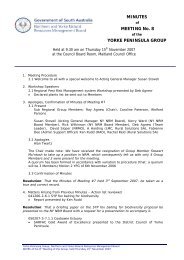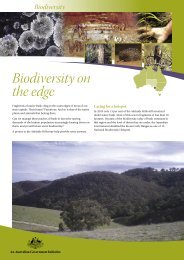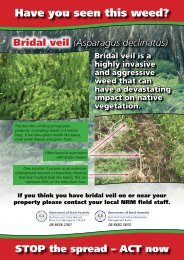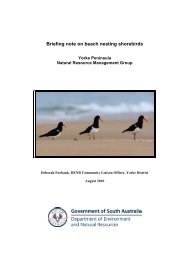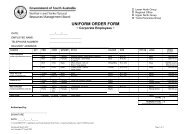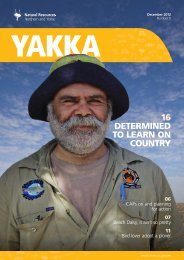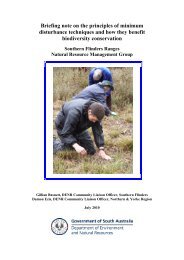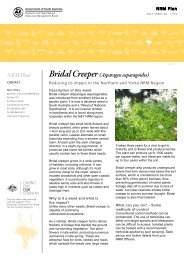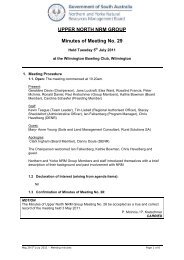Caring for country - Northern and Yorke Natural Resources ...
Caring for country - Northern and Yorke Natural Resources ...
Caring for country - Northern and Yorke Natural Resources ...
You also want an ePaper? Increase the reach of your titles
YUMPU automatically turns print PDFs into web optimized ePapers that Google loves.
4feature<br />
<strong>Caring</strong> <strong>for</strong> <strong>country</strong><br />
Aboriginal Dreaming is a complex<br />
concept that traces the journeys<br />
<strong>and</strong> actions of ancestors <strong>and</strong> their<br />
relationship with the natural world.<br />
Trevor Gill reports.<br />
Dreaming stories link the past with the present in the<br />
l<strong>and</strong> or <strong>country</strong> to which an Aboriginal person belongs.<br />
The significance of what Aboriginal people call<br />
“<strong>country</strong>” – embracing its l<strong>and</strong> <strong>and</strong> waters – is central<br />
to all aspects of their lives <strong>and</strong> those of their <strong>for</strong>ebears.<br />
There are places that are meaningful <strong>and</strong> treasured<br />
<strong>for</strong> their association with birth, social interaction,<br />
ceremonies, hunting, gathering, travelling <strong>and</strong> death.<br />
They may be ancient camps or burial sites, stone<br />
quarries, hunting grounds <strong>and</strong> fish traps, paintings<br />
or engravings or l<strong>and</strong> <strong>for</strong>ms that help shape the<br />
Dreaming stories.<br />
History, laws <strong>and</strong> consequence belong in these places.<br />
You can see it in the eyes of people like Aboriginal<br />
Elder Lindsay Sansbury. It is a look into the long ago.<br />
Uncle Tinto, as he is known among his people, lives<br />
at Point Pearce <strong>and</strong> his spiritual links with the l<strong>and</strong><br />
<strong>and</strong> sea in this northern region of <strong>Yorke</strong> Peninsula are<br />
strong <strong>and</strong> deep.<br />
Across the <strong>Northern</strong> <strong>and</strong> <strong>Yorke</strong> region there are various<br />
nations of Aboriginal people, each with heritage values<br />
that go back through countless generations. In each<br />
of these places, Aboriginal people are being engaged<br />
in structured natural resource actions that respect <strong>and</strong><br />
support key aspects of their traditional <strong>country</strong>.<br />
So there is a fascinating <strong>and</strong> fruitful interface between<br />
the custodial values of Indigenous people that are<br />
passed from one generation to another with broader<br />
conservation values.<br />
Indeed, natural resource management seeks to protect<br />
<strong>and</strong> maintain many of the natural features that are<br />
embodied in the Dreaming stories <strong>and</strong> the way of life<br />
of Aboriginal people today.<br />
“It is about reviving the <strong>country</strong> to a state that<br />
resembles the way it was in the past,” says Aboriginal<br />
L<strong>and</strong>care Coordinator, Roger Rigney. “Areas of the<br />
<strong>country</strong> are looking tired <strong>and</strong> sick. Aboriginal people<br />
believe that healthy <strong>country</strong> means healthy people.”<br />
Uncle Tinto is among a group of people at Point Pearce<br />
that has been working on boxthorn removal <strong>and</strong><br />
fencing in s<strong>and</strong> dunes as part of an NYNRM Boardfunded<br />
program to restore degraded <strong>country</strong>.<br />
“Many of our Dreaming stories that we pass on to<br />
younger people today are about the natural birds <strong>and</strong><br />
animals of our region,” he said. “But seeing<br />
is believing.<br />
“We have to help the <strong>country</strong> get back to the healthy<br />
way it was so that the birds <strong>and</strong> animals will return.<br />
If we don’t, future generations will miss out on the<br />
comings <strong>and</strong> goings of the natural world.<br />
“That’s why it is so important to have natural resource<br />
management programs like the boxthorn removal at<br />
Point Pearce.”<br />
The Aboriginal groups in the <strong>Northern</strong> <strong>and</strong> <strong>Yorke</strong><br />
region are the Narrungga, Nukunu, Ngadjuri,<br />
Adnyamathanha, Pitjantjatara <strong>and</strong> Yankuntjatara.<br />
The NYNRM Board’s engagement with the Indigenous<br />
communities in the region is through the Aboriginal<br />
L<strong>and</strong>s Trust (ALT), which holds l<strong>and</strong> in trust <strong>for</strong><br />
Indigenous people. With NYNRM Board funding,<br />
the ALT employs people to carry out natural<br />
resource projects.<br />
Chris Rains, the Trust’s L<strong>and</strong>care Coordinator, said:<br />
“The Indigenous people are paid <strong>for</strong> their work as an<br />
investment not only in NYNRM outcomes, but also in<br />
developing work skills.<br />
“This engagement also involves people in the<br />
management of their <strong>country</strong> in line with their cultural<br />
heritage values. For example, the Wadgedin Scrub<br />
area at Point Pearce is a very special place <strong>for</strong> the<br />
local people, however it has been subjected to illegal<br />
dumping threatening vegetation <strong>and</strong> habitat.<br />
“Through an NYNRM project, the Wadgedin Scrub is<br />
being revegetated <strong>and</strong> restored to its natural state.<br />
There is also a major box thorn removal program at<br />
Point Pearce.”<br />
Other recent NRM projects on Aboriginal l<strong>and</strong>s include<br />
pest management at Yapala, Point Pearce <strong>and</strong> Baroota,<br />
fencing off s<strong>and</strong> dunes at Point Pearce to prevent<br />
vehicle access <strong>and</strong> subsequent revegetation with local<br />
native species, <strong>and</strong> training programs including use of<br />
machinery <strong>and</strong> safe chemical h<strong>and</strong>ling.<br />
“We have also run a feral cat control program on<br />
Wardang Isl<strong>and</strong> to protect fairy penguins that inhabit<br />
the isl<strong>and</strong>,” Chris said.<br />
“The activities are carefully supervised with outcomes<br />
reported in detail to the Board, which funds the onground<br />
projects. The outcomes are measured in terms<br />
of hectares of l<strong>and</strong> subjected to pest plant or animal<br />
control <strong>and</strong> revegetation, kilometres of fencing erected<br />
or restored, <strong>and</strong> numbers of people participating in<br />
NRM related training programs.”<br />
Darcy Evans, an Elder of the Nukunu people, said<br />
natural resource management training had positive<br />
benefits <strong>for</strong> community members in terms of<br />
developing work skills that could lead to employment.<br />
“Also, it is rewarding that the Board provides such<br />
opportunities because when we work on our l<strong>and</strong> it<br />
lifts mental <strong>and</strong> spiritual health.”<br />
Above: Community members take part in a<br />
Reefwatch program at Point Pearce.<br />
Right: Tom Wanganeen (left) <strong>and</strong> Carlo<br />
Sansbury plant trees <strong>for</strong> a revegetation<br />
program at Point Pearce.<br />
Photos: Dragi Markovic<br />
20 <strong>Northern</strong> <strong>and</strong> <strong>Yorke</strong> <strong>Natural</strong> <strong>Resources</strong> Management Board




